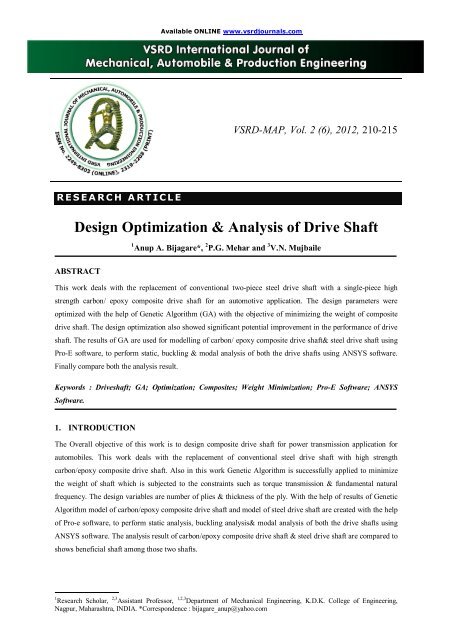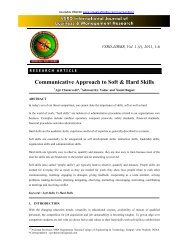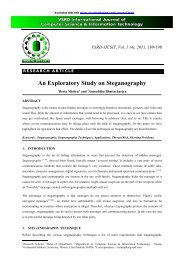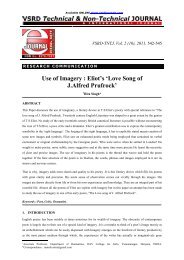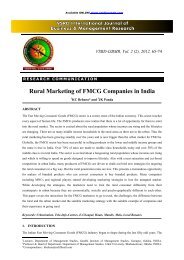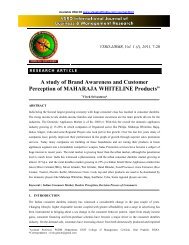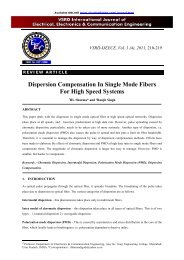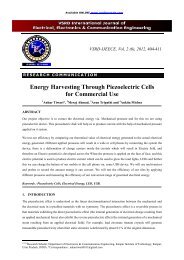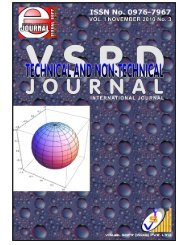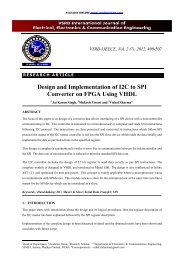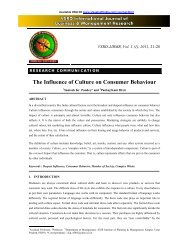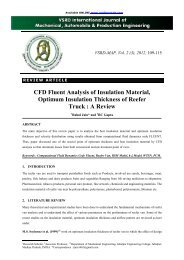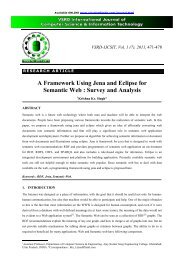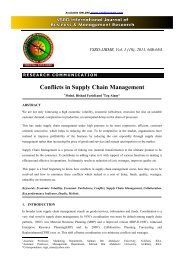Design Optimization & Analysis of Drive Shaft - vsrd international ...
Design Optimization & Analysis of Drive Shaft - vsrd international ...
Design Optimization & Analysis of Drive Shaft - vsrd international ...
You also want an ePaper? Increase the reach of your titles
YUMPU automatically turns print PDFs into web optimized ePapers that Google loves.
R E S E A R C H A R T II C L E<br />
____________________________<br />
Available ONLINE www.<strong>vsrd</strong>journals.com<br />
VSRD-MAP, Vol. 2 (6), 2012, 210-215<br />
<strong>Design</strong> <strong>Optimization</strong> & <strong>Analysis</strong> <strong>of</strong> <strong>Drive</strong> <strong>Shaft</strong><br />
ABSTRACT<br />
1 Anup A. Bijagare*, 2 P.G. Mehar and 3 V.N. Mujbaile<br />
This work deals with the replacement <strong>of</strong> conventional two-piece steel drive shaft with a single-piece high<br />
strength carbon/ epoxy composite drive shaft for an automotive application. The design parameters were<br />
optimized with the help <strong>of</strong> Genetic Algorithm (GA) with the objective <strong>of</strong> minimizing the weight <strong>of</strong> composite<br />
drive shaft. The design optimization also showed significant potential improvement in the performance <strong>of</strong> drive<br />
shaft. The results <strong>of</strong> GA are used for modelling <strong>of</strong> carbon/ epoxy composite drive shaft& steel drive shaft using<br />
Pro-E s<strong>of</strong>tware, to perform static, buckling & modal analysis <strong>of</strong> both the drive shafts using ANSYS s<strong>of</strong>tware.<br />
Finally compare both the analysis result.<br />
Keywords : <strong>Drive</strong>shaft; GA; <strong>Optimization</strong>; Composites; Weight Minimization; Pro-E S<strong>of</strong>tware; ANSYS<br />
S<strong>of</strong>tware.<br />
1. INTRODUCTION<br />
The Overall objective <strong>of</strong> this work is to design composite drive shaft for power transmission application for<br />
automobiles. This work deals with the replacement <strong>of</strong> conventional steel drive shaft with high strength<br />
carbon/epoxy composite drive shaft. Also in this work Genetic Algorithm is successfully applied to minimize<br />
the weight <strong>of</strong> shaft which is subjected to the constraints such as torque transmission & fundamental natural<br />
frequency. The design variables are number <strong>of</strong> plies & thickness <strong>of</strong> the ply. With the help <strong>of</strong> results <strong>of</strong> Genetic<br />
Algorithm model <strong>of</strong> carbon/epoxy composite drive shaft and model <strong>of</strong> steel drive shaft are created with the help<br />
<strong>of</strong> Pro-e s<strong>of</strong>tware, to perform static analysis, buckling analysis& modal analysis <strong>of</strong> both the drive shafts using<br />
ANSYS s<strong>of</strong>tware. The analysis result <strong>of</strong> carbon/epoxy composite drive shaft & steel drive shaft are compared to<br />
shows beneficial shaft among those two shafts.<br />
1 Research Scholar, 2,3 Assistant Pr<strong>of</strong>essor, 1,2,3 Department <strong>of</strong> Mechanical Engineering, K.D.K. College <strong>of</strong> Engineering,<br />
Nagpur, Maharashtra, INDIA. *Correspondence : bijagare_anup@yahoo.com
Anup A. Bijagare et al / VSRD International Journal <strong>of</strong> Mechanical, Auto. & Prod. Engg. Vol. 2 (6), 2012<br />
1.1. The Genetic Algorithm<br />
GA is non-traditional method <strong>of</strong> optimization in which solving the problem <strong>of</strong> minimise or maximise the<br />
objective function. On traditional algorithm are very difficult to solve manually. Solution for the non-traditional<br />
method can be obtained computerising algorithm using c-language. GA is the direct search algorithm based on<br />
the mechanics <strong>of</strong> biological evolution.GA is developed by John Holland university <strong>of</strong> Michigan (1970’s) .To<br />
understand the adaptive process <strong>of</strong> the natural systems. To provide efficient, effective techniques for<br />
optimization & machine learning applications.<br />
1.2. Introduction <strong>of</strong> <strong>Drive</strong> <strong>Shaft</strong><br />
Fig. 1: Two Piece <strong>Drive</strong> <strong>Shaft</strong> Arrangement for Rear Wheel Vehicle Driving System<br />
The drive shaft is one <strong>of</strong> the important parts in the automobiles which correspond to design with rear wheel<br />
drive and front engine installation. The weight reduction <strong>of</strong> the drive shaft can have a certain role in the general<br />
weight reduction <strong>of</strong> the vehicle and it is a highly desirable goal. If it can be achieved without increased in cost<br />
and decreased in quality and reliability. It is possible to achieve design <strong>of</strong> composite drive shaft with less weight<br />
to increase the natural frequency <strong>of</strong> the shaft and to decreases the bending stress. By doing this the torque<br />
transmission and torsion buckling capabilities are maximized.<br />
2. COMPOSITE MATERIAL<br />
Composite consist <strong>of</strong> two or more material phase that are combine to produce a material that has superior<br />
properties to these <strong>of</strong> its individual constituent. Technologically the most important composite are those in<br />
which the dispersed phase is in the form <strong>of</strong> fibre. The design <strong>of</strong> fibre-reinforced composite is based on the high<br />
strength and stiffness on a weight basis, the principal basis. The principle fibres in commercial use are various<br />
types <strong>of</strong> glass, carbon, graphite and Kevlar. Here carbon fibres are selected as potential material for the design<br />
<strong>of</strong> shaft.<br />
Table 2.1 : Properties <strong>of</strong> High Strength Carbon/Epoxy Composite Material<br />
Property Symbol Unit HS Carbon /E-poxy Steel<br />
Young's Modulus E Gpa 210 207<br />
Poisson Ratio V 0.3 0.3<br />
Density Kg/m 3 1600 7600<br />
Shear strength Ss Mpa 420 370<br />
Shear Modulus G Gpa 70 80<br />
211
Anup A. Bijagare et al / VSRD International Journal <strong>of</strong> Mechanical, Auto. & Prod. Engg. Vol. 2 (6), 2012<br />
3. SPECIFICATION OF THE PROBLEM<br />
The torque transmission capability <strong>of</strong> the drive shaft for passenger cars, small trucks, and vans should be larger<br />
than 3500 Nm (Tmax) and fundamental natural bending frequency <strong>of</strong> the drive shaft should be higher than 6500<br />
rpm (Nmax) to avoid whirling vibration. The drive shaft outer diameter do should not exceed 100 mm due to<br />
space limitations. Here outer diameter <strong>of</strong> the shaft is taken as 90 mm. The drive shaft <strong>of</strong> transmission system<br />
was designed optimally to the specified design requirements<br />
4. DESIGN OF STEEEL DRIVE SHAFT<br />
Mass <strong>of</strong> the steel drive shaft<br />
Table 4.1 : <strong>Design</strong> Parameter <strong>of</strong> Steel <strong>Drive</strong> <strong>Shaft</strong><br />
Parameter <strong>of</strong> <strong>Shaft</strong> Symbol Value Unit<br />
Outer Diameter do 90 mm<br />
Inner Diameter di 83.36 mm<br />
Length Of the <strong>Shaft</strong> L 1250 mm<br />
Thickness Of shaft T 3.32 mm<br />
m= AL= × ×( do 2 - di 2 ) ×L … (1)<br />
m = 8.58<br />
Torque transmission capacity <strong>of</strong> steel drive shaft<br />
T= Ss× ×[( do 4 - di 4 ) × do ] … (2)<br />
T = 55.93 ×<br />
4.1. Fundamental Natural Frequency<br />
Lateral or Bending Vibration : The shaft is considered as simply supported beam undergoing transverse<br />
vibration .Natural frequency can be found using the Timoshenko Beam Theory - Ncrt.<br />
Timoshenko Beam Theory - Ncrt : It considers both transverse shear deformation as well as rotary inertia<br />
effects. Natural frequency based on the Timoshenko beam theory is given by<br />
a<br />
= natural frequency base on Timoshenko beam theory, HZ<br />
= Shear coefficient <strong>of</strong> lateral natural frequency<br />
… (3)<br />
212
Anup A. Bijagare et al / VSRD International Journal <strong>of</strong> Mechanical, Auto. & Prod. Engg. Vol. 2 (6), 2012<br />
p = 1, first natural frequency<br />
r = mean radius <strong>of</strong> shaft<br />
Shape factor, 2 for hollow circular cross section<br />
= 0.982<br />
5. DESIGN OF COMPOSITE DRIVE SHAFT<br />
… (4)<br />
For designing a composite drive shaft, Genetic Algorithm (GA) is successfully applied to minimization <strong>of</strong> the<br />
weight <strong>of</strong> the shaft which is subjected to the constraints such as torque transmission, torsional buckling<br />
capacities and fundamental natural frequency. The design variables are number <strong>of</strong> plies and thickness <strong>of</strong> the ply.<br />
5.1. Formulation <strong>of</strong> Work for Genetic Algorithm<br />
Objective Function : To minimize the weight <strong>of</strong> the shaft.<br />
(Mass) m = AL= × ×( do 2 - di 2 ) ×L … (5)<br />
<strong>Design</strong> Variable : No. <strong>of</strong> ply thickness <strong>of</strong> ply<br />
3200.1< >0.5<br />
6. RESULT OF GENETIC ALGORITHM<br />
Table 6.1 : Result <strong>of</strong> Genetic Algorithm<br />
7. FINITE ELEMENT ANALYSIS USING ANSYS<br />
7.1. <strong>Analysis</strong> Procedure<br />
… (6)<br />
In this research, finite element analysis is performed using ANSYS 11.0 s<strong>of</strong>tware. The model <strong>of</strong> both the<br />
composite shaft & steel shaft created in Pro-e s<strong>of</strong>tware, are imported in the ANSYS s<strong>of</strong>tware. The shaft is<br />
213
Anup A. Bijagare et al / VSRD International Journal <strong>of</strong> Mechanical, Auto. & Prod. Engg. Vol. 2 (6), 2012<br />
subjected to torsion. The shaft is fixed at one end in axial, radial and tangential directions and is subjected to<br />
torsion at the other end. After performing a static analysis <strong>of</strong> the shaft, the output <strong>of</strong> static analysis is used to<br />
calculate the buckling load. The output <strong>of</strong> the buckling analysis is a load coefficient which is the ratio <strong>of</strong> the<br />
buckling load to the static load. This s<strong>of</strong>tware also calculates the modes <strong>of</strong> buckling <strong>of</strong> the composite shaft. The<br />
modal analysis is performed to find the natural frequencies in lateral directions.<br />
7.2. Results <strong>of</strong> Finite Element <strong>Analysis</strong><br />
Table 7.1 : Results <strong>of</strong> Finite Element <strong>Analysis</strong><br />
<strong>Analysis</strong> Type Composite <strong>Shaft</strong> Steel <strong>Shaft</strong><br />
Static <strong>Analysis</strong><br />
Total Deformation 0.27026 10 -2 mm 1.1981 10 -2 mm<br />
Maximum Principal Elastic Strain 6.117e -6 mm/mm 40.905 10 -6 mm/mm<br />
Maximum Principal Stress 1.4616 Mpa 8.3599 Mpa<br />
Maximum Shear Elastic Strain 8.7279 e -6 mm/mm 54.993 e -6 mm/mm<br />
Maximum Shear Stress 0.70495 Mpa 4.3783 Mpa<br />
Equivalent Stress 1.3606 Mpa 8.5473 Mpa<br />
Buckling <strong>Analysis</strong><br />
Total Deformation 0.15151 10 -3 mm 0.69922 10 -3 mm<br />
Fig. 7.1 : <strong>Analysis</strong> Results in ANSYS S<strong>of</strong>tware<br />
214
8. CONCLUSION<br />
Anup A. Bijagare et al / VSRD International Journal <strong>of</strong> Mechanical, Auto. & Prod. Engg. Vol. 2 (6), 2012<br />
The high strength carbon/epoxy composite drive shaft has been design to replace conventional steel drive shaft<br />
<strong>of</strong> an automobile.<br />
A one piece composite drive shaft for rear wheel drive automobiles has been design optimally by using Genetic<br />
Algorithm (GA) for high strength carbon/epoxy composites with the objective <strong>of</strong> minimization <strong>of</strong> weight <strong>of</strong><br />
shaft, & analyzed using ANSYS for better torque transmission capacity and bending vibration characteristics.<br />
When the value <strong>of</strong> tk= 0.31 and n = 8 then the weight <strong>of</strong> composite drive shaft is 1.36 kg i.e. the weight saving<br />
by the composite drive shaft as compared to steel drive shaft is about 83.47 %.<br />
These results are encouraging and suggest that GA can be used effectively and efficiently in other complex and<br />
realistic designs <strong>of</strong>ten encountered in engineering applications.<br />
9. REFERENCES<br />
[1] Anup A. Bijagare, P.G. Mehar & V.N. Mujbaile, "<strong>Design</strong> <strong>Optimization</strong> <strong>of</strong> <strong>Drive</strong> <strong>Shaft</strong>" ISSN No-2231-<br />
5063 Associated & Indexed by EBSCO,U.S.A. International Recognition Research Journals Golden<br />
Research Thoughts, Vol.1,Issue.IX/March 2012pp.1-4.<br />
[2] Anup A. Bijagare, P.G. Mehar & V.N. Mujbaile, "Genetic Algorithms in Computer-Aided <strong>Design</strong>"<br />
International Conference ,at shri Shankarprasad Agnihotri College <strong>of</strong> Engg. Wardha, 5 th & 6 th Feb 2012.<br />
[3] "OPTIMIZATION FOR ENGINEERING DESIGN", by Kalyanmoy Deb.<br />
[4] Thimmegowda RANGASWAMY and Sabapathy VIJAYARANGAN, “Optimal Sizing and stacking<br />
Sequence <strong>of</strong> Composite <strong>Drive</strong> shafts” ISSN 1392–1320 MATERIALS SCIENCE (MEDŽIAGOTYRA).<br />
Vol.11, No.2. 2005.<br />
[5] T.Rangaswamy, S. Vijayarangan, R.A. Chandrashekar, T.K. Venkatesh and K.Anantharaman, “Optimal<br />
<strong>Design</strong> and <strong>Analysis</strong> <strong>of</strong> Automotive Composite <strong>Drive</strong> <strong>Shaft</strong>”, International Symposium <strong>of</strong> Research<br />
Students on Materials Science and Engineering December 2002-04 Chennai India.<br />
[6] M. A. Badi, A. Mahd, A. R. Abutali, E. J. Abdullaand R. Yonus, “Automotive Composite <strong>Drive</strong> <strong>Shaft</strong>s:<br />
Ivestigation <strong>of</strong> the DsignVriables Effects”, International Journal <strong>of</strong> Engineering and Technology, Vol. 3,<br />
No.2, 2006, pp. 227-237.<br />
[7] R.R Ajith, T. Rangaswamy, S. Vijayarangan and G. Chandramohan, “Genetic Algorithm Based Optimum<br />
<strong>Design</strong> <strong>of</strong> Composite <strong>Drive</strong> <strong>Shaft</strong>”, International Symposium <strong>of</strong> Research Students on Material Science and<br />
Engineering December 20-22, 2004, Chennai, India.<br />
[8] "Introduction to Composites ", Daniel B. Miracle and Steven L. Donaldson, Air Force Research Laboratory.<br />
[9] M.A.K. Chowdhuri, R.A. Hossain," Department <strong>of</strong> Mechanical Engineering", International Journal <strong>of</strong><br />
Engineering and Technology Vol. 2(2), 2010, 45-48.<br />
[10] A. Valenza, V. Fiore, G. Di Bella," SPECIFIC MECHANICAL PROPERTIES OF GLASS/CARBON<br />
EPOXY COMPOSITES FOR MARINE APPLICATIONS".<br />
[11] Dai Gil Lee, Hak Sung Kim, Jong Woon Kim, Jin Kook Kim," <strong>Design</strong> and manufacture <strong>of</strong> an automotive<br />
hybrid aluminum /composite drive shaft", Composite Structures 63 (2004) 87–99.<br />
���<br />
215


